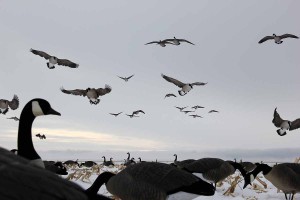
 When it comes to developing a good duck decoy spread you’ll often need a well thought out strategy and a bit of luck. Although duck hunting season is primarily over, it is never too early to discuss effective strategies. And when it comes to decoy spreads, strategies can become quite complex and contradict each other. For instance is it best to have a large spread or small spread? This answer will change from hunter to hunter and will vary from location to location. While there is no distinct way to set up a spread, the best rule of thumb is to imagine you are the duck and to decide what the duck wants to see in a spread. Here is a list of some of the most important things to consider when developing a decoy spread.
When it comes to developing a good duck decoy spread you’ll often need a well thought out strategy and a bit of luck. Although duck hunting season is primarily over, it is never too early to discuss effective strategies. And when it comes to decoy spreads, strategies can become quite complex and contradict each other. For instance is it best to have a large spread or small spread? This answer will change from hunter to hunter and will vary from location to location. While there is no distinct way to set up a spread, the best rule of thumb is to imagine you are the duck and to decide what the duck wants to see in a spread. Here is a list of some of the most important things to consider when developing a decoy spread.
Observe the Area
When setting up the decoys, try to use decoys that resemble ducks of the area. Also consider the best locations for the decoys to look natural. Should they be placed in a field or should they be placed in a body of water? Additionally, wind patterns should be considered as well.
Forming the Spread
While some hunters consider quality over quantity as being the best approach to a spread, many hunters object and believe that more decoys means more ducks. In most cases, large spreads tend to be more attractive to flocks of waterfowl, as they are easier to spot from far distances. In setting up a large spread it is important to put your most realistic decoys in the front and most apparent locations and to put your floaters in locations where they will blend in with the crowd. Some hunters use spreads that contain over 1000 carefully placed decoys! It is also important to remember to leave plenty of landing area within your spread. If there are too many decoys and no place to land by your blind then the whole hunt can be ruined.
Add Some Activity
If possible assemble a jerk string to some of the decoys to add some activity and movement in water spreads. This will stand out to nearby circling ducks and act as a larger magnet to land there.
Adjust to the Season
As duck season comes to an end, ducks tend to be more paranoid and travel in larger flocks. In many areas there is also ice and snow and the ducks begin acting different due to migration patterns. These changes mean that spreads and hunting tactics need to be modified. As the season winds to an end, spreads should become larger and more inviting to the ducks.
DOA Decoys hand-crafts high-quality waterfowl decoys in Algona, IA. After spending months reviewing the art portfolios of some of the most renowned waterfowl carvers in North America, they stumbled upon not one but two world class, world champion carvers who would combine their unrivaled mastery of wildfowl carving to create the perfect line of gunning decoys.




Leave a reply